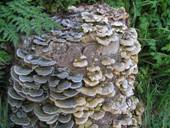Many-zoned polypore (Coriolus versicolor)
The many-zoned polypore is widespread throughout the whole world. IT grows on dead, lying deciduous tree trunks and stumps and is frequently found in forests and woodlands, particularly on beech trees. The fungus attacks stored round wood and also timbers used in outdoor applications as well as wood exposed to the elements in window frames, posts, railway sleepers and in gardens.
The many-zoned polypore causes serious White rot. The affected wood often shows dark fungal lines on it. Of the forest fungi, it is one of the most effective degraders of dead wood, and in laboratory experiments, it is also very active. It can cause beech wood to lose 60 – 70% of its mass within a few months. The many-zones polypore is a stipulated test fungus for testing the effectiveness of wood preservatives.
How can many-zoned polypores be recognised?
The fruiting bodies of these polypores are divided into zones which are yellowish, brownish or greyish black in colour. On the margins, the colouring is often lighter. They have no stem and sit on the wood, arranged like wings or fans. When growing in large colonies, which is often the case, the fruiting bodies are arranged on top of each other like roof slates.
They have a tough, leathery texture and are flexible. They are normally 3 – 8 cm long, 2 – 5 cm wide and 1 – 9 mm thick, and it is the colourful appearance of the various zones that gave this particular fungus its name.
